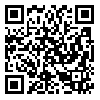BibTeX | RIS | EndNote | Medlars | ProCite | Reference Manager | RefWorks
Send citation to:
URL: http://rehabilitationj.uswr.ac.ir/article-1-1296-en.html
2- University of Isfahan, Isfahan, Iran. ,
Objective: In the study, a novel wearable miniaturized human computer interface system was designed and implemented. It allowed disabled people, who are not able to move their limbs voluntarily and speech overtly, to express their intentions and feelings just by moving their eyes.
Materials & Methods: The developed system that is installed on a pair of glasses, records the electrooculogram signal and transfers the digitized data wirelessly to a laptop. Realtime analysis of the signals allows users to utilize two high performance graphical user interfaces a keypad and a game, just by their eye movements. The performance of the developed system was tested on six normal people, who typed a total number of 1071 characters successfully, to evaluate accuracy and rate of typing. It was also tested by four people with quadriplegia and cerebral palsy who performed a computer game by using their eye movements.
Results: According to results of the experiments on normal people, the accuracy of recognizing the user's intention was obtained 94.1% and the average rate of communication was 7.72 characters per minute. Evaluating the usability of the system for disabled people showed that they were able to perform the computer game using their eyes. The percentage of success was evaluated as an average of 58.7%.
Conclusion: The proposed system recorded and processed elecrooculogram signals with appropriate quality. The final prototype of the system was 2.6 cm× 4.5 cm in size and weighted only 15 grams. The total power consumption was measured as 123 mW. The designed keypad provided selection of each character by minimum eye movements. The system assures high performance for communication as well as high level of mobility and comfort for everyday use.
Received: 7/06/2013 | Accepted: 7/10/2013 | Published: 15/06/2014
| Rights and permissions | |
 |
This work is licensed under a Creative Commons Attribution-NonCommercial 4.0 International License. |





